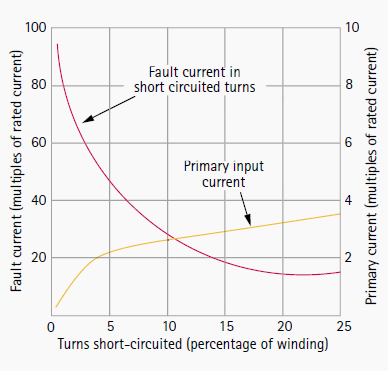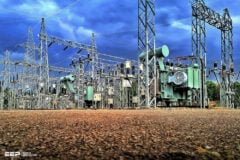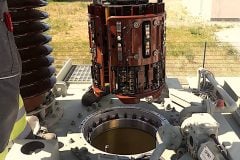A fault on a transformer winding is controlled in magnitude by the following factors:
- Source impedance
- Neutral earthing impedance
- Transformer leakage reactance
- Fault voltage
- Winding connection

Several distinct cases arise and are examined below.
Star-Connected Winding with Neutral Point Earthed through an Impedance
The winding earth fault current depends on the earthing impedance value and is also proportional to the distance of the fault from the neutral point, since the fault voltage will be directly proportional to this distance. For a fault on a transformer secondary winding, the corresponding primary current will depend on the transformation ratio between the primary winding and the short-circuited secondary turns.
This also varies with the position of the fault, so that the fault current in the transformer primary winding is proportional to the square of the fraction of the winding that is shortcircuited.
The effect is shown in Figure 1 – Faults in the lower third of the winding produce very little current in the primary winding, making fault detection by primary current measurement difficult.

Star-connected winding with Neutral Point Solidly Earthed
The fault current is controlled mainly by the leakage reactance of the winding, which varies in a complex manner with the position of the fault. The variable fault point voltage is also an important factor, as in the case of impedance earthing. For faults close to the neutral end of the winding, the reactance is very low, and results in the highest fault currents.
The variation of current with fault position is shown in Figure 2.

For secondary winding faults, the primary winding fault current is determined by the variable transformation ratio; as the secondary fault current magnitude stays high throughout the winding, the primary fault current is large for most points along the winding.
Delta-connected Winding
No part of a delta-connected winding operates with a voltage to earth of less than 50% of the phase voltage. The range of fault current magnitude is therefore less than for a star winding. The actual value of fault current will still depend on the method of system earthing; it should also be remembered that the impedance of a delta winding is particularly high to fault currents flowing to a centrally placed fault on one leg.
As the prefault voltage to earth at this point is half the normal phase voltage, the earth fault current may be no more than the rated current, or even less than this value if the source or system earthing impedance is appreciable. The current will flow to the fault from each side through the two half windings, and will be divided between two phases of the system.
The individual phase currents may therefore be relatively low, resulting in difficulties in providing protection.
Phase to Phase Faults
Faults between phases within a transformer are relatively rare; if such a fault does occur it will give rise to a substantial current comparable to the earth fault currents.
Interturn Faults
In low voltage transformers, interturn insulation breakdown is unlikely to occur unless the mechanical force on the winding due to external short circuits has caused insulation degradation, or insulating oil (if used) has become contaminated by moisture.
The interturn insulation of the end turns is reinforced, but cannot be increased in proportion to the insulation to earth, which is relatively great. Partial winding flashover is therefore more likely. The subsequent progress of the fault, if not detected in the earliest stage, may well destroy the evidence of the true cause.
A short circuit of a few turns of the winding will give rise to a heavy fault current in the short-circuited loop, but the terminal currents will be very small, because of the high ratio of transformation between the whole winding and the short-circuited turns.

The graph in Figure 3 shows the corresponding data for a typical transformer of 3.25% impedance with the short-circuited turns symmetrically located in the centre of the winding.
Core Faults
A conducting bridge across the laminated structures of the core can permit sufficient eddy-current to flow to cause serious overheating. The bolts that clamp the core together are always insulated to avoid this trouble. If any portion of the core insulation becomes defective, the resultant heating may reach a magnitude sufficient to damage the winding.
The additional core loss, although causing severe local heating, will not produce a noticeable change in input current and could not be detected by the normal electrical protection; it is nevertheless highly desirable that the condition should be detected before a major fault has been created.
Tank Faults
Loss of oil through tank leaks will ultimately produce a dangerous condition, either because of a reduction in winding insulation or because of overheating on load due to the loss of cooling.
Overheating may also occur due to prolonged overloading, blocked cooling ducts due to oil sludging or failure of the forced cooling system, if fitted.
Externally Applied Conditions
Sources of abnormal stress in a transformer are:
- Overload
- System faults
- Overvoltage
- Reduced system frequency
RESOURCE: Network Protection & Automation Guide











What do you think about a delta-wye distribution transformer that has high resistance in the x1-x0 connection? The other portions of the winding test pretty much the same but the portion of the winding is showing a deviation of 1.4 while doing a TTR test on every single tap, and higher resistance on the wye portion by nearly 1200% ?
I want book which contains all about transformer in pdf format.
Have you searched guides?
Very good article, thank you for providing such a good and educative reading.
I would like to know in which reference I could find the equations or winding model to be able to obtain short circuit contributions for internal faults in a winding. I´ve seen curves like Figure 2 and Figure 3 of this article but I could never find any reference that provide how to get them.
Thank you.
Good
Good portal for Electrical Engineer
my question is what are the conditions for under frequency and over frequency tripping
To Engr. Edvard and Engr. Guparmar, How are you guys! Its very nice to have website like what you are founded. I congratulate both of you for being helpful and supportive to all electrical enthusiast around the region. Any way, I ask a favor to both of you, can you send a topic regarding AC and DC drives, their scientific principle and how does it works.
thank you very much and keep up the good work guys. More power!